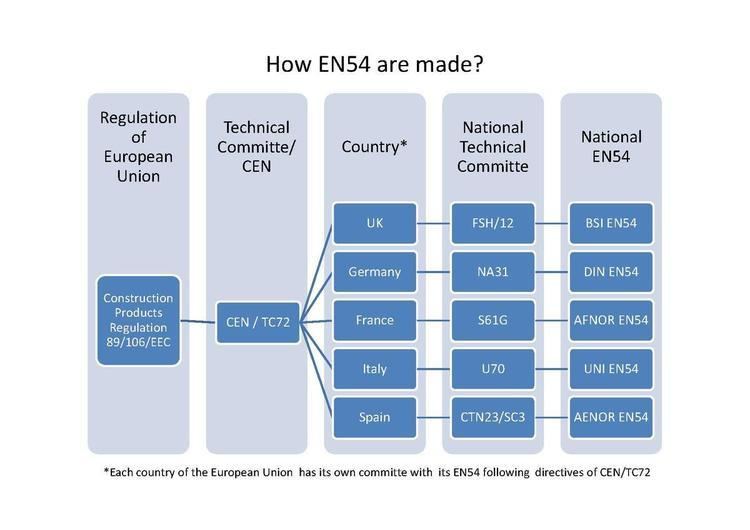 | ||
The EN 54 Fire detection and fire alarm systems is a mandatory standard that specifies requirements and laboratory test for every component of fire detection and fire alarm system and it allows the free movement of construction products between countries of the European Union market.
Contents
- Mandatory standard in the European countries
- Construction Products Directive 89106EEC
- Construction Products Regulation
- Technical Committees
- TC Technical Committee CENTC72 Automatic fire detection system and fire alarm
- CE evaluation of conformity
- EN 54 Standard Family Parts
- References
It was developed and approved by European Committee for Standardization (CEN, French: Comité Européen de Normalisation).
This standard is widely recognized around the world for several countries outside of European Union. It is recognized in Latin American countries, Brasil, African and Asian countries and several islands in the Pacific Ocean.
Mandatory standard in the European countries
According to the Construction Products Regulation, it is mandatory that Fire Detection and Fire Alarm equipment is certified under EN 54 standard by an authorized certification body.
Only when this condition has been satisfied can the CE mark be properly affixed to the product, recognising and demonstrating that the product fulfills the European Union safety and performance requirements and thereby allowing free trade inside the European Union. Therefore, CE mark is a legal requirement for trade within the EU. Any other mark is voluntary and can not substituted the CE mark.
The Construction Products Regulation (CPR) has been adopted by the European Commission and replaces the Construction Products Directive (CPD) as from 1 July 2013.
It is to ensure the free movement of all construction products within the European Union by harmonizing technical standards with respect to the essential requirements applicable to construction products in terms of health and safety.
The main goal is to ensure that construction products are only introduced to the European market if they are fit for their intended use.
Construction Products Directive 89/106/EEC
This Directive related to all construction products for installation in any member country of the European Union. It was repealed and replaced by The Construction Products Regulation.
Construction Products Regulation
The Construction Products Regulation is titled in full "Regulation (EU) No 305/2011 of the European Parliament and of the Council of 9th March 2011 laying down harmonised conditions for the marketing of construction products and repealing Council Directive 89/106/EEC", and is intended to simplify and clarify the legal framework in this field which was established by Directive 89/106/EEC.
The Regulation provides that where a harmonised technical standard exists for a construction product as defined by the Regulation, that product must be tested and certified to that standard by a notified body in order to qualify for a CE Mark. Since EN 54 is the harmonised technical standard for fire detection and alarm products, it appears to follow that products in that field which are brought to market in the European Union must be tested against the provisions of EN 54 and certified accordingly.
The Construction Products Regulation (CPR) came into effect from 1 July 2013; products which are placed on the market in the EU after that date must comply with the provisions of the Regulation, and by extension therefore with EN 54.
Technical Committees
You are able to see all Technical Committees at the CEN website: http://www.cen.eu/cen/Sectors/Sectors/Construction/Pages/Workprogramme.aspx
(TC) Technical Committee CEN/TC72 Automatic fire detection system and fire alarm
It is the TC responsible of developing the normative for fire detection system in the EU and responsible for coordination with committees of each member country to update information and making new normative in fire detection system. The committee of each member country report and depend directly from CEN/TC 72. These committees must inform updates and new normative that is received from CEN/TC72 to responsible office, departments or national organization which has been managed the normative of Fire detection system inside of every member country. These national committees must carry the necessities and new requirement of the industry and user of each country member of Fire detection system to the CEN/TC72 that is the European Committee which is responsible of update and change normative of fire detection system in the European Union.
CE evaluation of conformity
For a product to carry a CE Mark, it must fulfill the essential requirements. Fire alarm and Fire detection products, therefore, must follow the requirement laid down in the Construction Products Regulation for testing by a notified body to be carried out against the harmonised technical standard in the field - EN 54.
The testing procedure, which is laid down in detail in EN 54, must be carried out by the approved notified body and the official certificatory Declaration Of Performance should be provided by that body.
Following table show the requirement of each system.
EN 54 Standard Family Parts
The standard has been published in a number of parts:
